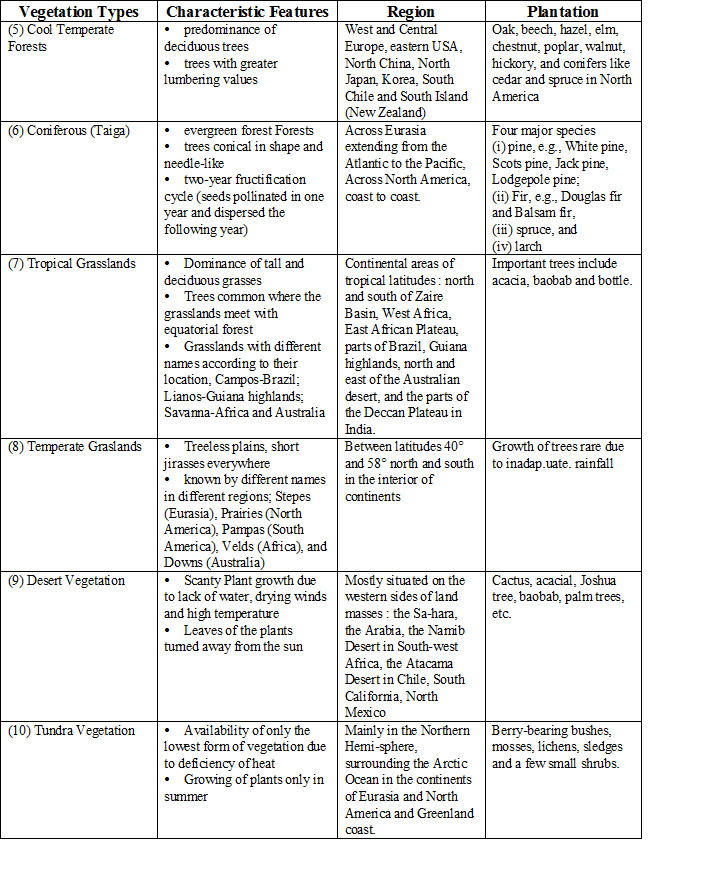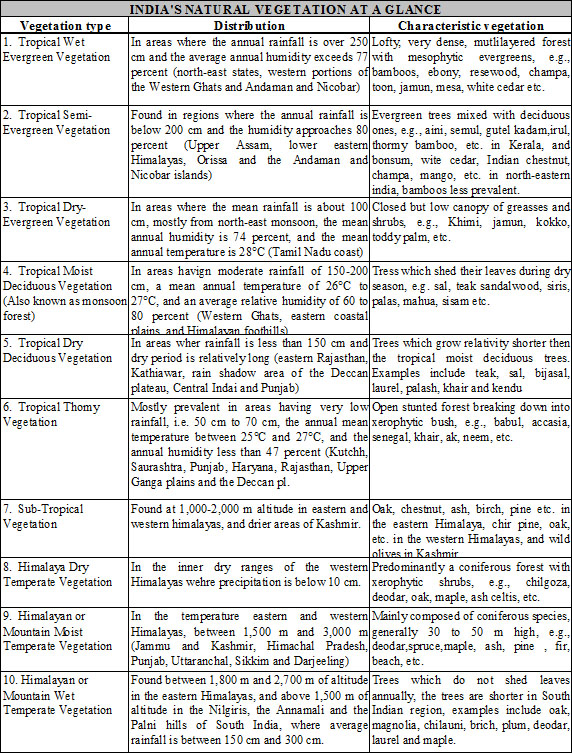Major Vegetation Types

v In studying the natural vegetation of India, it is necessary to know the distinction between flora, vegetation and forest. ‘Flora’ refers to plants of a particular region or period, listed by species and considered as a group. ‘Vegetation’ refers to assemblage of plant species living in association with each other in a given environmental frame-often termed as ecological frame. The word forest is generally used to denote a large tract covered by trees and shrubs.

In India, much of forest and wildlife resources are either owned or managed by the government through the Forest Department or other government departments. These are classified as -
(i)Reserved Forests :
More than half of the total forest land has been declared reserved forests. Reserved forests are regarded as the most valuable as far as the conservation of forest and wildlife resources are concerned.
(ii) Protected Forests :
Almost one-third of the total forest areas is protected forest, as declared by the Forest Department. This forest land are protected from any further depletion.
(iii) Unclassed Forests :
These are other forests and wastelands belonging to both government and private individuals and communities.
(iv) India has been divided into the following five regions for studying forest distribution in the country. Percentage of forest coverage in these five regions is as follows :
* Himalayan region 18 per cent
* North Plain region 5 per cent
* Peninsular Hills and 57 per cent
Plateau regions
* Western Ghats and 10 per cent
Coastal regions
* Eastern Ghats and 10 per cent
Coastal regions
Total 100 per cent
WILDLIFE AND ITS CONSERVATION
1. The term “wildlife” refers to the wild undomesticated animals living in their natural habitats, such as forests, deserts and grasslands. Wild animals and plants make up an essential part of nature.
2. Wildlife is important to people for four main reasons :
(i) beauty
(ii) economic value
(iii) scientific value
(iv) survival value.
Wildlife biologists use three main classifications for animals and plants that face possible extinction.
3. Endangered Species are those that face the most serious threat of extinction. e.g., the California condor.
4. Threatened species are generally abundant in some area, but they face serious dangers due to excessive hunting, fishing or trapping, e.g., the grey wolf.
5. Rare species have small populations. They live in protected environments, and their numbers are not decreasing. The Torrey pine tree of California is an example of rare species.
(a) Wildlife In India
Wildlife of India is a great natural heritage. It is estimated that about 4-5 per cent of all known plant and animal species on the earth are found in India. The main reason for this remarkable diversity of life forms is the great diversity of the ecosystem which this country have preserved and supported through the ages. India has more than 1200 species of birds, 2500 species of fish and between 5 to 8 percent of the world’s amphibians, reptiles and mammals. India is the only country in the world that has both tigers and lions. The Himalayas have a large range of animals that survive the bitter cold.
(b) Conservation of Wildlife in India :